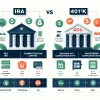
Fidelity Investments, one of the largest brokerage companies in the world, rolled out its latest offering last month: a trading account for 13- to 17-year-olds.
One view of Fidelity’s plan is that these accounts are a kind of Wall Street rearguard response to the Robinhood trends of 2021, with Reddit Bro’s driving cryptocurrencies and questionable stocks to the moon.
Fidelity needs to capture the customers of the future. It’s better that future investors engage with responsible financial institutions like Fidelity. Consistent with the trends of financial technology, the Fidelity Youth Account will have zero fees and no online commissions. There is no minimum balance, although the parent must have a Fidelity account already open.
The Fidelity Youth Account allows teens to buy and sell stocks, mutual funds and exchange-traded funds. It comes with a no-fee debit card, although a parent can deactivate the card by contacting Fidelity. The account can accept up to $30,000 in deposits per year.
My initial reaction to that last point: That’s a really big trading account to entrust to a teen!
Traditionally, minors have not been given the reins for their securities trading or investing. With their underdeveloped frontal lobes, high-risk tolerance and lack of obligations to care for others, teenagers have been considered cognitively on par with Las Vegas conventioneers at 2 a.m. Easy marks for the sharps.
Consistent with that 2 a.m. Vegas consideration, the Fidelity Youth Account includes some training wheels. Parents can monitor the account through account. And it forbids penny stocks, leverage and options trading. I like that.
Inconsistent with that 2 a.m. Vegas consideration, teens can buy and sell to their hearts’ content! Unfortunately, frequent trading — like spending time at the Vegas table — tends to leave us poorer, not richer.
I’m not overly worried about this, though. The reality is that few families outside of the very wealthy can afford to deposit the maximum $30,000 per year, or even a few thousand for little Katie’s discretionary trading. Any family that can put thousands into a teen’s account likely could handle any potential losses.
Arguably, the experience of losing a few thousand dollars could be a great lesson for Katie. It would help her grow into the family wealth and become an excellent long-term customer for Fidelity. In that sense, it’s a win-win for Katie’s family and Fidelity.
Although the Fidelity Youth Account for feels like a different kind of account than we’ve ever seen before, it is not without precedent. Other training-wheel financial architecture exists — other versions of youth accounts, some of which I’ve used in the past.
Since the 1960s, a Universal Transfers to Minors Act Account (UTMA) has allowed parents to hold stocks and mutual funds for children and make investment decisions on their behalf, with the assets reverting to the child when she turns 18. The point of an UTMA is generally to transfer and designate money specifically for a child, but without giving them any control of the money until they reach legal adulthood. I did that about eight years ago with individual stocks for my kids to teach them, without giving them the actual control. That’s one workaround.
A different solution — one I’ve also used — is to open a robo-advising account in my name and under my social security number, and have my daughters build a small portfolio, which I name for them. As far as the brokerage is concerned, I’m the customer. But it allows me to involve my kids in investment conversations, all while maintaining complete parental control.
But these training-wheel approaches fall short of giving the minor child what Fidelity has done, which is remove barriers to the joys and sorrows of directly buying and selling securities.
The Fidelity Youth Account roll-out this month paralleled a proud dad moment that I experienced last week. My 15-year-old received a $500 check for placing second in a statewide writing contest sponsored by the State Bar of Texas. She’s also earned a bunch of money this spring caring for a neighbor’s cats. All this income earned outside the home allowed us to open her first Roth IRA last week, with me as custodian.
With her small balance, we invested in ETFs. The best thing about the Roth IRA is that she cannot have the money back until she retires. (I know, I know — Roth IRAs allow you to access the money earlier than retirement under a number of circumstances, but she doesn’t need to know that. Please don’t tell her.) Since I am the custodian, there’s going to be no trading in this account. Which I think will make her wealthier in the long run than would a trading account that she could control.
When the U.S. Senate finally confirms me as the National Personal Financial Benevolent Dictator, I will improve upon Fidelity’s plan in ways that will make it more closely resemble the Roth IRA my daughter opened this past week.
The biggest rule change I will make as NPFBD: You can invest your money, kid, but you can’t have it back for many years. Maybe 10 years? Maybe 50 years? I don’t know. Ten years feels about right. That ought to incentivize the long-term view. “If I can just hold on to my GME stock for another few hours, I’ll make enough to buy an XBox” is the kind of behavior I’m trying to discourage in teens here.
Hopefully, the families able to take advantage of a Fidelity Youth Account know what they’re doing. Hopefully, they’ll be fine.
Michael Taylor is a columnist for the San Antonio Express-News and author of “The Financial Rules for New College Graduates.”
michael@michaelthesmart
money.com |twitter.com/michael_taylor







